Why use a muzzle?
Comfortably wearing a muzzle is a great skill for any dog to have. Chances are it will be necessary to wear one at some point during their life. The veterinary hospital is the most common place a muzzle may be needed. Some veterinary procedures are painful and having a dog who is comfortable wearing a muzzle is beneficial. Acute abdominal pain, trauma (such as a broken leg), or back pain are examples of issues an owner may encounter at home with their dog that can be extremely painful. Any dog has the potential to bite and pain can make that more likely.
Muzzles can also provide greater freedom for many dogs. Muzzles should never be viewed as punishment, and we can often help dogs learn to ask to wear their muzzle. Historically, muzzles have been associated with aggressive or biting dogs. There was a stigma attached to muzzles that suggested people using them were not kind to their dog.
Muzzles can also be used to prevent dogs from ingesting inappropriate items such as discarded food, corncobs, dead animals, food wrappers, and bark mulch. These items can cause GI upset or obstructions and may require expensive and invasive surgeries. There are basket muzzles specially designed for this purpose.
Many dogs are fearful and fear increases the risk of biting. This danger often leads to an isolated life and makes it difficult for owners to give their dog enough enrichment and exercise. By teaching a dog to wear a muzzle, you can safely work on behavior modification while allowing your dog to be around other dogs and people. A bonus for the dog that does not want to be approached by unfamiliar people is that the average person does not want to approach a dog wearing a basket muzzle.
What kind of muzzle is best?
There are different kinds of muzzles. For short procedures at a veterinary clinic, a sleeve muzzle may be used. This type of muzzle prevents a dog from opening their mouth, which makes it difficult to pant, drink water, or eat treats. A basket muzzle allows the dog to pant, take treats, and drink but reduces potential injuries from a bite. There are many different styles of basket muzzles, including custom fit muzzles that may be needed for those dogs with wide or flat faces.
Desensitization/Counterconditioning steps
Desensitization starts with a muzzle, tasty treats, and a quiet environment. There are four main parts to this process: introducing the muzzle, increasing the time the dog’s face is in the muzzle, attaching the straps, and then increasing activity while wearing the muzzle.
Step 1: Introducing your Dog to the Muzzle
- Start with the muzzle on the floor with treats in and around it.
- Allow your dog to approach and move the muzzle to get the treats.
- If your dog seems nervous about this step, try leaving the muzzle in an area of your home where they may feel more comfortable approaching it. Every now and then replenish the treats that are in and around the muzzle.
- Hold the basket muzzle with the opening facing your dog and the straps moved out of the way. Put treats inside the muzzle and offer it to your dog to approach and eat the treats.
Nose in muzzle with treats in hand
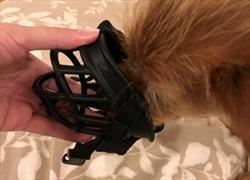
Photo courtesy of Sandra Robbins
- It should always be your dog moving towards the muzzle, not the muzzle moving towards your dog.
- When offering the muzzle, make sure it is near you and at your dog’s nose level.
Step 2: Increasing Time of Your Dog’s Nose in the Muzzle
- Present an empty muzzle in one hand with treats in the other hand behind your back. When your dog puts his nose in the muzzle looking for treats, instantly feed them through the muzzle.
Muzzle on nose
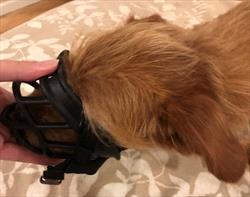
Photo courtesy of Sandra Robbins
- Prolong the time between treats while your dog’s nose is in the muzzle.
- If your dog backs out of the muzzle, let them without pushing the muzzle toward them.
- Start with treating once every other second for three to five seconds
- One, treat, three, treat, five, treat
- Then give one treat every third and fifth second for five to ten seconds
- One, two, treat, four, treat, six, seven, treat, nine, treat
- Extend the time gradually in this way so that your dog is not expecting constant treats
Step 3: Introducing the straps
Dog wearing muzzle
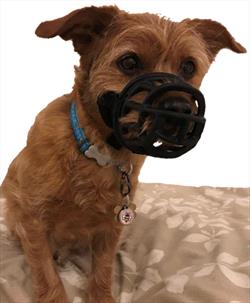
Photo courtesy of Sandra Robbins
- While your dog’s nose is in the muzzle waiting for the next treat, begin to lift the straps of the muzzle near your dog’s head and then drop them and give your dog a treat.
- To free your hands for connecting the straps around your dog’s head, consider resting the muzzle in your lap or on a pillow.
- Progress with the straps slowly up and around your dog’s head until your two hands can touch behind your dog’s head.
- When you first get the straps connected, immediately disconnect them, and give your dog a treat.
- The next time after connecting the straps, give your dog a treat and then take the muzzle off.
- Gradually increase the number of treats your dog can eat while wearing the muzzle.
Step 4: Make it fun
- Once your dog seems comfortable wearing the muzzle, have them wear it for something fun like a hike with you or a ride in the car.
Dogs walking with muzzles.jpg
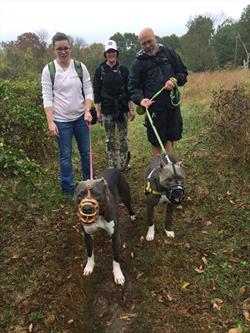
Photo courtesy of Sandra Robbins
- It is important to monitor your dog for discomfort while wearing the muzzle and take it off before they become worried about it.
- Creating positive associations with the muzzle will make it a more pleasant experience for your dog.
If your dog seems to be having a difficult time with any of these steps, back up to a step they seemed more confident with and reinforce before moving on to the next step.
To make the muzzle look more fun and less intimidating, decorate it! Some fun options are to use decorative tape or to glue colorful gems to it. You could decorate your dog’s muzzle to match your favorite sports team’s colors. Your dog won’t care what the muzzle looks like, but bright colors create a different association for the people around your dog.
Decorated muzzles
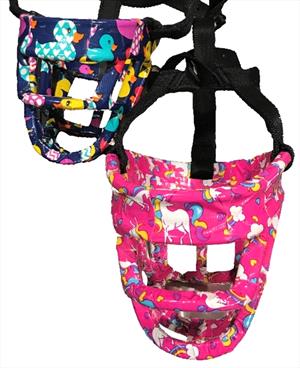
Photo courtesy of Sandra Robbins
Decorated muzzles
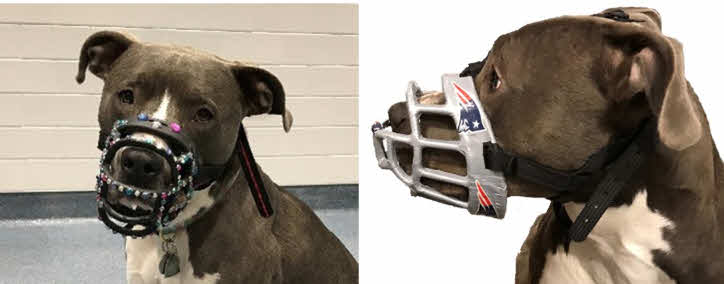
Photos by Sandra Robbin.